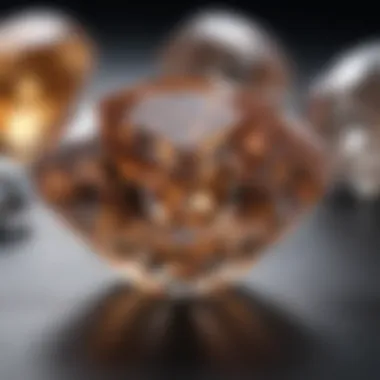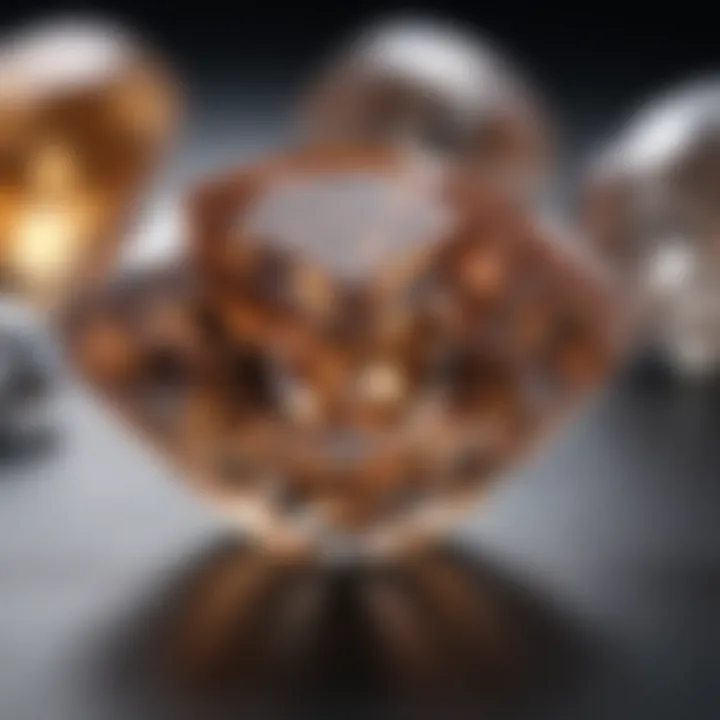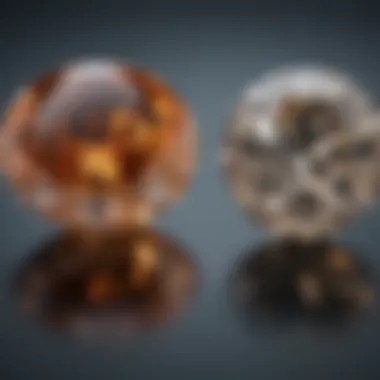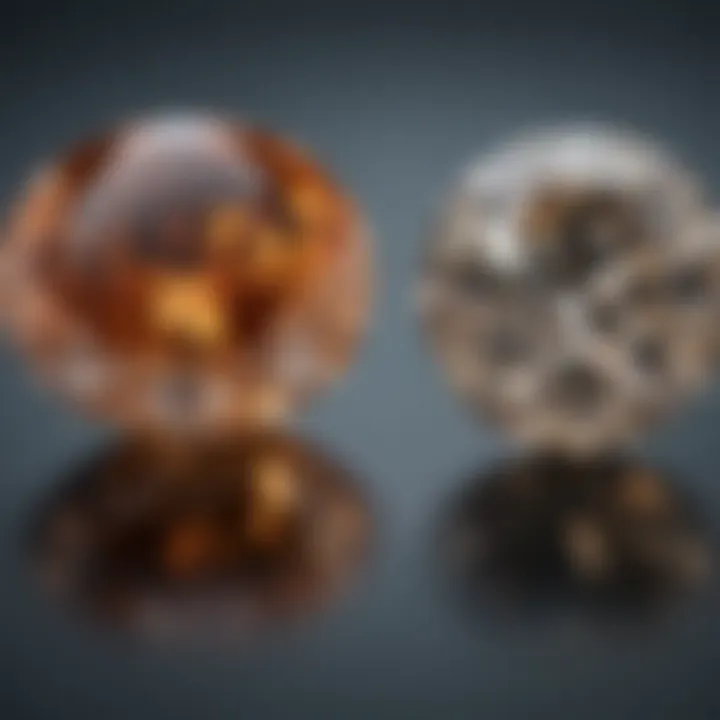HPHT and CVD Diamond Synthesis Techniques Explained


Intro
The world of diamonds, with their striking brilliance and historical allure, has captivated humanity for centuries. As we dive into the synthesis techniques that have revolutionized diamond production, two processes stand out distinctly: High Pressure High Temperature (HPHT) and Chemical Vapor Deposition (CVD). These advanced methodologies are not merely about crafting gemstones; they tell a story of innovation, ethics, and sustainability that resonates deeply across the jewelry market.
Gemstone Overview
Definition and Origins
Diamonds, at their core, are a form of carbon. Formation naturally occurs under intense heat and pressure, primarily found in the Earth’s mantle. However, lab-grown diamonds challenge the very essence of this natural phenomenon. By replicating these extreme conditions in a controlled environment, HPHT technology enables manufacturers to create diamonds that are virtually indistinguishable from their mined counterparts.
This contrasts with the CVD method, where gaseous carbon materials are used to deposit layers of diamond onto a substrate. Both techniques yield diamonds that are chemically the same as natural ones, but the processes and implications behind them tell different tales.
Historical Significance
Lab-grown diamonds have evolved over the last few decades. While the concept of synthesizing diamonds might sound modern, experiments began as early as the 1950s. Initially, the results were rudimentary and not effective for commercial use. However, advancements in technology have since opened the floodgates for lab-created diamonds.
The significance of these developments is profound. Not only do they supply a growing market, but they also raise fundamental questions about ethics and environmental sustainability in the gemstone industry. This pivot from traditional mining to lab production signifies a broader shift in how we perceive value and authenticity in gemstones.
Gemstone Properties
Hardness and Durability
When talking about durability, nothing quite compares to diamonds. They boast a rating of 10 on the Mohs scale of hardness, which is the highest achievable. This well-known property ensures that both HPHT and CVD diamonds can withstand everyday wear without chipping or scratching. What’s perhaps more interesting is their durability is matched only by the technological prowess that creates them. As such, understanding this property alone provides insight into the value of lab-grown diamonds.
Color and Clarity
Both HPHT and CVD diamonds can exhibit a range of colors, from classics like colorless and near-colorless to vibrant hues such as pink or yellow. Thanks to the controlled environments in which they are created, producers can manipulate conditions to affect color and clarity.
Additionally, advancements in CVD methods have allowed for increasingly clearer stones with fewer inclusions. When considering these properties, one might realize that lab-grown diamonds offer similar, if not superior, aesthetic qualities when compared to traditionally sourced gems.
Prelims to HPHT and
In the ever-evolving world of gemstones, diamonds hold a special place not just due to their inherent beauty, but also because of their remarkable journey from deep within the Earth to the glittering displays in jewelry stores. The methods of creating these precious stones have advanced significantly, primarily through two cutting-edge techniques known as High Pressure High Temperature (HPHT) and Chemical Vapor Deposition (CVD). Understanding these methods is crucial for anyone invested in the diamond market, as they not only highlight the technological prowess of contemporary gemology but also pose significant implications for the future of diamond sourcing and consumer choice.
Understanding Diamond Formation
To grasp the significance of HPHT and CVD, one must first comprehend how natural diamonds form. Under extreme pressure and temperature conditions, carbon atoms crystallize into the diamond structure over millions of years in the Earth's mantle. This natural process is not just lengthy but requires very specific conditions that are usually only available deep underground. Conversely, the HPHT technique attempts to replicate these particular environments synthetically. The process involves subjecting carbon material to immense pressures and temperatures, mimicking the Earth’s conditions, thereby allowing for the creation of diamonds in a matter of weeks instead of millennia.
CVD, on the other hand, takes a different approach. This method leverages a gas-phase reaction to deposit carbon atoms onto a substrate, which gradually builds up layers of diamond. The gases used, often including methane, decompose under specific environments and, similar to their natural counterparts, form diamond through a series of controlled reactions.
In summary, both methods, while distinct in their execution, aim to harness the fundamental principles of diamond formation, enabling the synthesis of these gems in a laboratory setting.
Importance of Laboratory Synthesis
The ability to synthesize diamonds in a lab has ushered in a new era in the gemstone industry. Laboratory-grown diamonds, specifically those created using HPHT and CVD, offer a wide array of benefits that conventional mined diamonds cannot always promise. For one, these lab-grown options provide ethical assurance. Consumers today are more socially conscious and seek products that do not contribute to conflict or environmental degradation. With lab-grown stones, buyers can rest assured that their purchase does not support unethical mining practices.
Moreover, the technological advancements behind HPHT and CVD have produced diamonds that are virtually indistinguishable from their natural counterparts. Whether it's in terms of clarity, color, or carat weight, lab-grown diamonds can hold their own against mined stones, often at a more appealing price point.
Another noteworthy aspect of laboratory synthesis is the consistency and predictability it offers. Unlike natural diamonds, which can vary drastically in quality and color due to their formation environment, lab-grown diamonds undergo strict quality control measures, yielding stones with defined characteristics and less variability.
"In the realm of diamonds, HPHT and CVD are not just methods; they are game changers."
Through understanding HPHT and CVD, not only does one gain insight into the fascinating science behind diamond synthesis, but also into the broader implications for consumer behavior, ethical purchasing, and market dynamics. As these methods continue to evolve, so too will the standards and expectations of diamond buyers.
The HPHT Process Explained
The HPHT method, or High Pressure High Temperature, stands as a cornerstone in the laboratory synthesis of diamonds. This process mimics the natural conditions found deep within the Earth’s mantle where diamonds form. The significance of understanding HPHT lies not just in the birth of gems but also in the exploration of their physical and chemical properties, which impacts their use in diverse applications.
Historical Context of HPHT


The journey of HPHT began in the mid-1900s when researchers sought ways to create diamonds artificially. Early attempts were ambitious and often yielded limited results. It wasn’t until advancements in technology during the 1970s that the method matured. By employing pressurized carbon sources, scientists were able to replicate the conditions of extreme heat and pressure, paving the way for high-quality synthetic diamonds. Over the decades, the process has evolved, refining the methodologies and materials used, which in turn has influenced market demand and consumer perception of lab-grown gems.
Technical Overview
Pressure and Temperature Requirements
The crown jewel of the HPHT process is its stringent pressure and temperature conditions. Typically, temperatures range above 1,300 degrees Celsius and pressures exceed 5 GPa. These parameters are not just standards; they are essential for the carbon atoms to arrange themselves into the crystalline structure characteristic of diamonds. This specific criterion of temperatures ensures that the carbon undergoes a phase change, effectively solidifying into diamond. The high pressure acts like a sculptor’s hand, coaxing carbon to mold itself into a gem.
The unique feature of these requirements is their adaptability. Changes in pressure can facilitate the synthesis of different diamond types, allowing for versatility in production. However, the energy costs associated with creating and maintaining such extremes can be considerable, marking a negative facet in the overall efficiency of HPHT.
Materials Used in Synthesis
When discussing materials, carbon is the primary player, but it’s not alone. The HPHT process often incorporates catalysts — metals like iron, nickel, and cobalt are commonly employed. These materials lower the melting point of carbon, providing a conducive environment for diamond formation. The inclusion of these catalysts can significantly enhance the growth rate of diamond crystals, making the process more efficient and economically viable.
The key characteristic of materials used in this synthesis is their ability to withstand the extreme conditions without degrading, which means that quality control is paramount. The unique feature here is that the choice of catalyst can influence the color and clarity of the resulting diamond. While effective catalysts can lead to better outcomes, improper selection might lead to a lower-quality gem, which raises questions about consumer trust in HPHT diamonds.
Advantages of HPHT Diamonds
HPHT diamonds boast a myriad of advantages. Primarily, they share the same physical, chemical, and optical properties as natural diamonds. This consistency means that they can seamlessly replace natural stones in both jewelry and industrial applications. Furthermore, their production can be more environmentally friendly, considering the reduced need for mining.
A notable benefit lies in their ability to display unique colors, attributed to specific trace elements incorporated during the synthesis process, giving them a distinct market appeal.
Limitations of HPHT Diamonds
On the flip side, HPHT diamonds carry certain limitations that merit attention. The primary drawback is the high production costs. The energy demands for maintaining the required pressures and temperatures can drive up prices, although prices are often lower compared to their natural counterparts.
Additionally, some critique the method for making synthetic diamonds less desirable due to perceived lack of authenticity. Among connoisseurs, a notion persists that natural diamonds, with their rich histories, hold more value, despite the HPHT diamonds being chemically identical.
The Methodology
When we explore diamond synthesis, the Chemical Vapor Deposition (CVD) approach shines like a lighthouse guiding through the fog. This method is crucial for several reasons, mainly because it lays the groundwork for producing diamonds with high purity and tailored properties. Unlike its HPHT counterpart, CVD allows for better control over the diamond's qualities. This is important for various fields ranging from jewelry to electronics.
Origins and Development
The roots of CVD can be traced back to scientific curiosity in the mid-20th century. Initially developed for other applications, researchers soon recognized the potential for diamond creation. The first successful synthesis of lab-grown diamonds via CVD occurred in the 1980s. Over the years, it evolved into a sophisticated method that continues to adapt and grow, ensuring that diamonds created today meet a range of niche demands.
Process Details
Gas Mixtures and Plasma Creation
The heart of the CVD methodology lies in its gas mixtures and plasma. The process typically involves a blend of methane and hydrogen gases. When subjected to conditions like high temperatures and an electric field, these gases transform into plasma. This is no small feat; the plasma acts as a catalyst, breaking down the gas molecules, allowing carbon atoms to precipitate and crystallize into diamond form.
The key characteristic of this method is its ability to create a controlled environment. This controlled plasma formation becomes a favorable choice for achieving desirable diamond characteristics, such as size and clarity.
A unique feature of this gas mixture process is its adjustability. By tweaking the ratio of gases, one can manipulate the growth rate and quality of the diamond. While this aspect presents numerous advantages, it does require precise monitoring and a certain level of expertise to avoid issues like unwanted impurities.
Growth Conditions
Growth conditions play a pivotal role in the effectiveness of the CVD methodology. A uniform substrate temperature is critical for diamond growth. Fluctuations can lead to inconsistent quality or even obstruct the diamond's development.
A key aspect of growth conditions is maintaining a certain pressure and temperature within the reactor chamber. These conditions are beneficial as they ensure a steady rate of carbon deposition, allowing for ideal crystal formation. Special care in managing these parameters can mostly result in high-quality diamond gems.
However, this approach does also present challenges. The need for specialized equipment and an understanding of thermal dynamics can be daunting for newcomers in the field. Nonetheless, the advantages far outweigh these challenges when we look at the remarkable outcomes achievable using CVD.
Benefits of Diamonds
CVD diamonds come packed with benefits that distinguish them in the market. These lab-grown gems are often less expensive than their mined counterparts. Since they can be produced on-demand, they directly address issues of supply chain inconsistencies and ethical concerns surrounding diamond mining. Moreover, their quality can often surpass that of natural diamonds, with fewer inclusions and a cleaner finish. The ability to create larger stones and tailor their attributes means that customers can find exactly what they're looking for without compromise.
Challenges


Despite the advantages, the CVD methodology is not without its challenges. The technology requires a significant upfront investment in equipment, which can be a barrier for smaller companies or individual entrepreneurs. Furthermore, the time taken to produce high-quality diamonds can be longer than traditional methods, although the end result can justify the wait.
Comparative Analysis of HPHT and
When considering the ever-evolving landscape of diamond synthesis, understanding the distinctions and similarities between HPHT and CVD methods becomes essential. This comparative analysis is not just a mere academic exercise, but a practical exploration that sheds light on how these processes impact everything from the properties of the diamonds produced to consumer preferences and market dynamics. Each method brings its unique characteristics and implications, making it vital for enthusiasts and collectors to grasp their nuances.
Structural Differences
The structural variance between diamonds created through HPHT and CVD is a focal point of this comparison. HPHT diamonds often replicate natural diamonds more closely because the HPHT process mimics the intense heat and pressure conditions in the earth’s mantle where diamonds naturally form. The resultant gems frequently exhibit distinct crystal structures, primarily the cubic lattice arrangement typical of most natural diamonds.
On the other hand, CVD diamonds, while maintaining a cubic lattice structure, often display softer textures and can bear unique growth patterns due to how the CVD method introduces carbon atoms into a plasma state, allowing them to accumulate layer by layer.
This leads to a notable difference in the hardness and durability of the stones. HPHT diamonds may show slight advantages in toughness, while CVD diamonds can boast substantial customization during their growth process, leading to stones with diverse properties suited for various markets.
Moreover, the formation speed is another aspect worth noting. HPHT diamonds generally require a more extended period under extreme pressures and temperatures, while CVD diamonds can be produced more rapidly in controlled environments. This key difference is not just about time; it extends to the scalability of production and pricing.
"Understanding the structural differences helps buyers comprehend how the synthesis affects the gemstone’s overall characteristics."
Optical Characteristics
The optical traits of HPHT and CVD diamonds also vary significantly and are critical in determining their desirability. HPHT diamonds tend to exhibit higher levels of brilliance and fire due to their natural-like formation processes, capturing light in ways that can mimic older, established natural diamonds. They usually present fewer inclusions, which can enhance their optical appeal.
CVD diamonds, conversely, can sometimes struggle with light performance due to the nature of their growth process. These diamonds may present specific optical phenomena such as graining, which may detract from their allure, though advancements in CVD technology are consistently improving their performance.
Importantly, both types can be engineered to meet specific optical requirements. Jewelers interested in bespoke designs can choose from CVD diamonds that carry unique characteristics based on custom growth settings, allowing for a tailored approach to gemstone design.
In essence, while HPHT diamonds emulate the natural brilliance that many collectors prize, CVD diamonds present a canvas for innovation in optical design. Thus, the choice between these two types depends significantly on individual preferences for traditional attributes versus modern advancements in personalization.
Both methods produce diamonds that hold their own place in the market but appeal to different segments, affecting buyers' decisions in profound ways.
Market Implications of Lab-Grown Diamonds
The rise of lab-grown diamonds has heralded a new chapter in the gemstone industry, reshaping the market dynamics like never before. As consumers become increasingly aware of environmental and ethical considerations, lab-grown diamonds are slowly carving out a significant niche in the market. This transformation not only affects consumer choices but also influences various economic factors that surround the traditional diamond trade.
Consumer Preferences
Modern consumers are notably more conscious about what they buy. Skimming through social media feeds or browsing eco-conscious blogs, they encounter a surge of information about the detrimental effects of traditional diamond mining. It’s not just about looking good anymore; it's about feeling good about purchases too.
Factors affecting these changes in consumer preferences include:
- Ethical Concerns: More and more, buyers are prioritizing the ethical origin of their diamonds. Lab-grown options offer a way to secure a sparkling gem without the shadow of conflict associated with some mined diamonds.
- Sustainability: Today's shoppers are leaning towards offerings that reflect their eco-friendly values. Lab-grown diamonds are often viewed as a sustainable alternative, as they typically have a lower environmental impact than their mined counterparts.
- Price Sensitivity: Lab-grown diamonds can be significantly more affordable than natural diamonds, appealing to budget-conscious consumers without compromising on quality or beauty.
In short, lab-grown diamonds are ensnaring consumer hearts, aligning with values that resonate in this age of conscious shopping.
Economic Factors
The introduction of lab-grown diamonds has set the stage for a shift in economic landscapes within the gemstone industry. Businesses that once thrived on mined diamonds are now competing against these synthetic alternatives, and the ramifications are multifold:
- Price Competition: Lab-grown diamonds can be produced for a fraction of the cost, leading to increased price competition between lab-grown and mined diamond retailers. This price war can benefit consumers significantly, as they now have the opportunity to choose high-quality diamonds for less.
- Market Growth: The burgeoning demand for lab-grown diamonds has spurred innovation and investment in technology, further driving market growth. As companies refine synthesis processes, they can produce larger, higher-quality stones more efficiently.
- Job Displacement and Creation: While some traditional mining jobs may dwindle, new tech-based roles in lab synthesis and distribution are surfacing, showcasing a shift in the nature of employment in the industry.
The landscape of the diamond market is evolving, and the influences of lab-grown diamonds extend far beyond consumer choice. As both consumers and businesses adapt, the face of the entire industry is likely to change in ways we are only beginning to comprehend.
Through understanding these market implications, buyers can navigate this new environment with a clearer perspective, making informed decisions that align with their values and budgets.
Environmental and Ethical Considerations
The discussion surrounding lab-grown diamonds—HPHT and CVD—extends beyond the technical merits and aesthetic qualities of the gems. At the core of this dialogue lies a critical reflection on the environmental and ethical factors associated with diamond synthesis. As the market for these lab-created stones burgeons, it becomes increasingly important to assess their impact not only on the planet but also on societal values and ethical sourcing.
Sustainability of Lab-Grown Diamonds


Sustainability is a buzzword that carries significant weight in today’s gemstone market. Unlike their natural counterparts, lab-grown diamonds present an opportunity to mitigate environmental degradation associated with traditional diamond mining. Natural mining often leads to:
- Habitat destruction: The extraction process can ravage local ecosystems, disrupting flora and fauna.
- Water pollution: Toxic substances released during mining can contaminate water sources, posing risks to both wildlife and human populations.
- Carbon footprint: Transporting diamonds from remote mines contributes to greenhouse gas emissions.
Conversely, lab-grown diamonds like those produced through HPHT or CVD methods typically consume far less energy overall. For instance, several studies suggest that creating diamonds in controlled environments can use renewable energy, thereby decreasing their overall carbon footprint. While some might argue that energy-intensive equipment is required, the total resource allocation per carat is often favorable when compared to the impact of mining.
Moreover, many companies engaging in lab-grown diamond synthesis emphasize accountability in their production processes. This includes adopting ethical practices that ensure fair labor conditions and potentially using recycled materials. The control over production processes means that businesses can actively pursue sustainability initiatives, such as:
- Implementing stricter waste management protocols.
- Employing carbon-neutral manufacturing practices.
- Reducing resource consumption through innovative technology.
Justifying Ethical Choices
Ethical considerations in the diamond industry have gained prominence as consumers become increasingly aware of the implications of their purchases. Lab-grown diamonds present an ethical alternative to mined diamonds, which have, at times, been entangled in controversial issues such as conflict financing and exploitation of labor.
Opting for lab-grown diamonds allows consumers to enjoy the beauty and allure of diamonds without the ethical weight that often accompanies mined stones. Some key ethical elements include:
- Conflict-free guarantee: Lab-grown diamonds do not contribute to funding conflict, offering peace of mind to conscientious buyers.
- Transparency in sourcing: Many producers provide detailed accounts of their manufacturing practices, enhancing trust in the purchasing process.
- Empowerment of local communities: With reduced reliance on mining, communities that previously depended on diamond extraction can pivot to more sustainable economic activities.
However, it's also pertinent to understand the challenges that lay ahead. The transition away from mined diamonds requires educational efforts to inform consumers about the distinctions between lab-grown and natural stones. Moreover, as lab-grown diamonds gain prominence, manufacturers must strive to maintain ethical standards throughout their production chains. One misstep could tarnish the reputation of lab-grown diamonds, leading to skepticism among consumers.
"Choosing lab-grown diamonds isn't just about aesthetics; it's a commitment to responsible consumption and a reflection of one's values."
In summary, the environmental and ethical considerations of lab-grown diamonds are multifaceted. While the positive aspects of sustainability and ethical sourcing lay a promising foundation, ongoing vigilance is essential to ensure that these ideals remain in practice as the industry continues to develop. This evolving sector not only signifies shifting cultural values but also paves the way for a more responsible and sustainable future in fine jewelry.
The Future of Diamond Synthesis
As the demand for lab-grown diamonds continues to rise, the future of their synthesis is becoming a hot topic. In the coming years, we can expect remarkable breakthroughs that will not only enhance the quality of the diamonds produced but also redefine how they are perceived in the marketplace. A shift in consumer preferences, coupled with technological advancements, suggests that HPHT and CVD processes will undergo significant transformation, leading to the creation of superior diamonds that meet both ethical and aesthetic standards. The importance of this topic cannot be overstated, as it intertwines scientific innovation with market dynamics.
Innovations on the Horizon
The field of diamond synthesis is not static; it is evolving at a pace that keeps many stakeholders on their toes. Several key innovations are anticipated:
- Enhanced Growth Techniques: Novel methods for diamond growth, such as advancements in plasma-enhanced CVD, are being researched. This can potentially increase the efficiency of the growth process, yielding diamonds faster while maintaining high quality.
- Nano-Diamond Applications: Future innovations might explore the smaller side of diamonds. Nano-diamonds are finding applications in various fields like medicine and electronics. These tiny gems could lead to new avenues of research and commercial utilization.
- Hybrid Techniques: The merging of HPHT and CVD techniques could offer diamonds with unmatched brilliance and clarity. By leveraging the strengths of both processes, manufacturers might create a new category of diamonds.
"In the ever-competitive diamond market, innovation is not just a buzzword; it’s a necessity. Companies that adapt to these changes will find themselves leading the charge."
Such innovations don’t only promise enhanced diamonds; they also hold vast potential for sustainability. Developing more efficient processes could mean less energy consumption, aligning with the growing concerns over environmental impact.
Impacts on Traditional Diamond Markets
As lab-grown diamonds gain popularity, their influence on traditional diamond markets is unmistakable. Here are some ramifications worth noting:
- Pricing Adjustments: The introduction of high-quality lab-grown diamonds has already begun to shake up pricing structures within the gem industry. Traditional diamonds, invariably linked to natural scarcity, may experience price pressures due to the availability and affordability of synthetic options.
- Consumer Choices: More consumers are gravitating towards ethical alternatives. This trend is shaping a new landscape in which the narrative of conflict-free sourcing plays a significant role. Lab-grown diamonds often symbolize a conscientious purchase, which appeals to a growing demographic focused on ethical consumption.
- Retail Adaptations: Jewelers and retailers will need to adapt to the changing market dynamics. They might start to offer more lab-grown options along with traditional ones, catering to a wider range of preferences.
- Investment Potential: There’s a burgeoning interest in lab-grown diamonds as investment assets. As their technology progresses and quality improves, they may find a place in investment portfolios usually reserved for natural diamonds.
As we look ahead, it is apparent that the evolution of diamond synthesis isn't just about technology. It's about reshaping how buyers view value, rarity, and ethics in diamond purchasing. The diamonds of tomorrow may shine brighter not just for their physical properties, but for the stories they tell and the choices they inspire.
Culmination
In closing, the examination of HPHT and CVD diamond synthesis has revealed much about the present landscape and future potential of lab-grown diamonds. Both processes, while rooted in different techniques, share a common goal: to mimic nature's remarkable ability to create diamonds, yet they diverge in their methods and results. Understanding these nuances is crucial for enthusiasts, collectors, and even jewelry designers.
Summarizing Key Points
To encapsulate the core aspects discussed in this article:
- Technological Insight: The processes of HPHT and CVD are not mere production methods; they are sophisticated techniques that illustrate human innovation and scientific advancement in material synthesis.
- Market Dynamics: The rise in popularity of lab-grown diamonds has shifted consumer preferences, challenging the traditional diamond market. Understanding this shift is essential for stakeholders aiming to navigate this evolving landscape.
- Environmental and Ethical Considerations: Lab-grown diamonds present a more sustainable and ethical alternative to mined diamonds. The implications of this choice resonate far beyond aesthetics, offering a path towards more environmentally friendly practices in the gem industry.
The synthesized diamonds, whether forged through HPHT or CVD, not only appeal on a visual level but also represent an evolution in ethical jewelry choices. With rising awareness around these topics, consumers are becoming more discerning, often weighing values alongside beauty.
Looking Ahead
Looking towards the future, the advancements in diamond synthesis technology may lead to even more innovative methods than HPHT or CVD. Research and development may uncover novel techniques that improve efficiency or enhance diamond quality further. As these technologies evolve, the distinction between lab-grown and naturally mined diamonds may blur even more, necessitating strict standards and certifications.
Additionally, the implications for traditional diamond markets could be profound. As lab-grown diamonds gain recognition for their beauty and ethical standing, established players in the diamond sector will need to adapt or risk obsolescence. This adjustment may foster collaborations between traditional and innovative markets, creating a unique hybrid of services and products that cater to diverse consumer bases.
As the journey of diamond synthesis moves forward, society will continually refine its understanding of worth, beauty, and sustainability in gemstones.
Ultimately, the dialogue surrounding HPHT and CVD diamonds isn't just about gemstones; it's about what these innovations reveal about our values and aspirations for the future.



